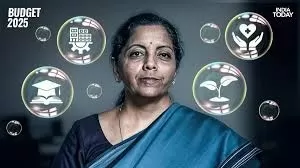Union Budget 2025: Investment in People, Economy, and Innovation
The Union Budget for 2025 introduces the theme of "investment as the third engine," emphasizing the importance of investing in people, the economy, and innovation to drive sustainable growth. With a comprehensive approach to welfare, infrastructure, and skilling, the government's plans aim to uplift various sectors and empower the youth of India for future challenges.

Investing in People: Key Welfare Programs
A significant portion of the budget focuses on investing in people, particularly children, women, and vulnerable groups. The Sakam Anganwadi and Portion 2.0 program is set to provide nutritional support to over 8 crore children, 1 crore pregnant women, and lactating mothers across India. It also targets approximately 20 lakh adolescent girls in aspirational districts and the Northeast region. The government plans to enhance the cost norms for this nutritional support, ensuring its sustainability and broader reach.
Another initiative is the expansion of broadband connectivity to all government secondary schools and Primary Health Centers (PHCs) in rural areas through the Bharat Net project. This infrastructure will empower educational and healthcare institutions in remote areas, enhancing access to vital services.
Fostering Innovation: Empowering Young Minds
The budget also highlights the government's focus on innovation through the creation of 50,000 Atal Tinkering Labs in government schools over the next five years. These labs will foster curiosity and scientific temper among young minds, enabling them to explore new ideas and technologies. This move is in line with the government's broader efforts to cultivate a culture of innovation and research in India.
Furthermore, the Bharatiya Basha Pak Scheme will provide digital Indian language books for schools and higher education, helping students understand their subjects in their native languages. This initiative will promote inclusivity in education and ensure that students from diverse linguistic backgrounds can learn more effectively.
Strengthening Skill Development
The National Centers of Excellence for Skilling initiative, announced in the previous year's budget, will see the establishment of five such centers with global expertise and partnerships. These centers aim to equip the youth with essential skills for both domestic and international markets. This expansion will cover curriculum design, training of trainers, skill certification frameworks, and periodic reviews to ensure that India’s workforce remains competitive on the global stage.
To further enhance skilling opportunities, the expansion of medical education is prioritized, with plans to add 10,000 additional undergraduate and postgraduate medical seats in the coming year. The government also plans to increase medical education capacity by adding 75,000 seats over the next five years. This growth will ensure that India’s healthcare system has the skilled professionals needed to meet the demands of an expanding population.
Enhancing Healthcare and Livelihoods
In addition to skilling, the government’s focus on healthcare includes plans to establish daycare cancer centers in all district hospitals over the next three years. The goal is to create 200 centers in the 2025-2026 period, increasing access to critical cancer treatment for rural and underserved populations.
For urban livelihoods, the government has introduced a scheme aimed at uplifting the urban poor and vulnerable groups. The scheme will focus on providing better incomes, sustainable livelihoods, and improved quality of life. The success of the PM Swan Scheme, which has already benefitted over 68 lakh street vendors by providing loans, will be built upon with enhanced loan limits and capacity-building support for vendors across the country.
Supporting the Gig Economy
The gig economy is another area receiving focused attention. The government recognizes the significant contributions of gig workers—those involved in online platforms—toward India’s modern services economy. To ensure their welfare, the government plans to offer identity cards and registration on the E-SHRAM portal, as well as provide health care under the PM Jaroja Yojana. This initiative is expected to assist nearly 1 crore gig workers, offering them better social security and health coverage.
Conclusion: A Vision for Sustainable Growth
In conclusion, the Union Budget 2025 outlines a broad and inclusive vision for the country’s future, aiming to boost growth through investments in people, innovation, and infrastructure. While the emphasis on skilling, healthcare, and urban livelihoods will help uplift vulnerable sections of society, the initiatives around innovation and digital education lay the foundation for India’s leadership in the global economy.
The success of these initiatives will depend on effective implementation, and their true impact will be seen in the coming years. However, the comprehensive approach to investment in human capital, technological advancement, and inclusive growth could position India for a transformative phase in the years ahead.
What's Your Reaction?















